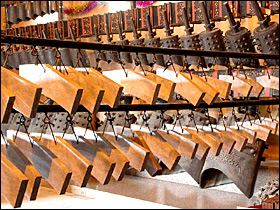The chime of bells is a wonderful work of art in Chinese bronze
culture and a crystallization of ancient civilization of mankind.
Under the ritual and musical institutions in ancient times, this
percussion instrument was a symbol of the owner's rank, power and
position and transcended all other musical instruments. Its design,
making and uses embodied the cream of culture in those days. The
ancient chime of bells serves as an important material evidence for
people of today to study history from a different angle.
A chime of bells and a set of musical stones were unearthed from
the tomb of the Marquis of Zeng at Leigudun, Suizhou, Hubei
Province in 1978. The chime of bells consisted of 65 pieces,
including 19 pieces of niuzhong (a bell with a
semi-circular knob on top) and 45 pieces of yongzhong (a
bell with a cylindrical handle on top) bells and a bo (a
large bell). They were suspended from a stand in three tiers and
nine groups. The whole chime of bells weighed more than 2,500
kilograms. Each bell bore gold-inlaid inscriptions about events,
notes and temperament. Each bell could produce two notes three
intervals apart. With three and a half octaves, the
yongzhong bells on the middle tier had a wide range and
clear timbre, playing the major role in a performance. The big and
thick yongzhong bells on the lower tier produced a deep
and long sound, creating harmony and enriching the atmosphere. The
niuzhong bells on the upper tier could be used as a
supplement to the yongzhong bells on the middle tier.
 |
The set of musical stones consisted of 32 pieces, laid out on two
tiers. Most of them were made of limestone (bluestone) and the rest
were made of marble. The musical stones bore inscriptions of
temperament. With a range of three and a half octaves, they
produced clear and melodious sound.
The chime of bells and the set of musical stones at the Big Bell
Temple Museum were reproductions made in 1990. Based on the twelve
- tone equal temperament, the chime of bells is tuned to the
international standard notes. The inscription on the upper part of
a bell indicates the temperament of the note produced from the
front of the lower part of the bell, and the inscriptions on the
front and side of the bell indicate the notes produced from the
front and side of the lower part of the bell respectively. The
reproduction embodies improvements on the original chime of
bells.
1. In the original chime of bells, the niuzhong bells
and the yongzhong bells were different in the temperament
and gong (a note of the ancient Chinese five- note scale,
corresponding to 1 in numbered musical notation). The reproduction
has adopted the same temperament, pitch standard and musical
alphabet, making it easier to play the niuzhong bells and
the yongzhong bells in unison and improving the musical
property of the whole chime of bells.
2. The reproduction has reduced the repetition of the same notes
produced by the original chime of bells and retuned some of the
bells producing the same notes so that they can produce other
necessary notes, thus enriching the rendition of music.
3. The note produced from the front of the lower part of a bell
is naturally superior to the note produced from the side of the
lower part of the bell. So the reproduction has made it possible
for the various notes in the note row to be produced from the front
of the lower part of bells with a view to facilitating the balance
of the notes in the course of rendition, especially after a
modulation of the modes of ancient Chinese music.
4. The reproduction has restored the original composition of the
second and third groups of bells on the upper tier before they were
buried in the earth, making it easier to play the reproduced chime
of bells.
The reproduced chime of bells has a range of five and a half
octaves and the whole of twelve semitones, so it can play ancient
and modern melodies, Chinese and foreign.